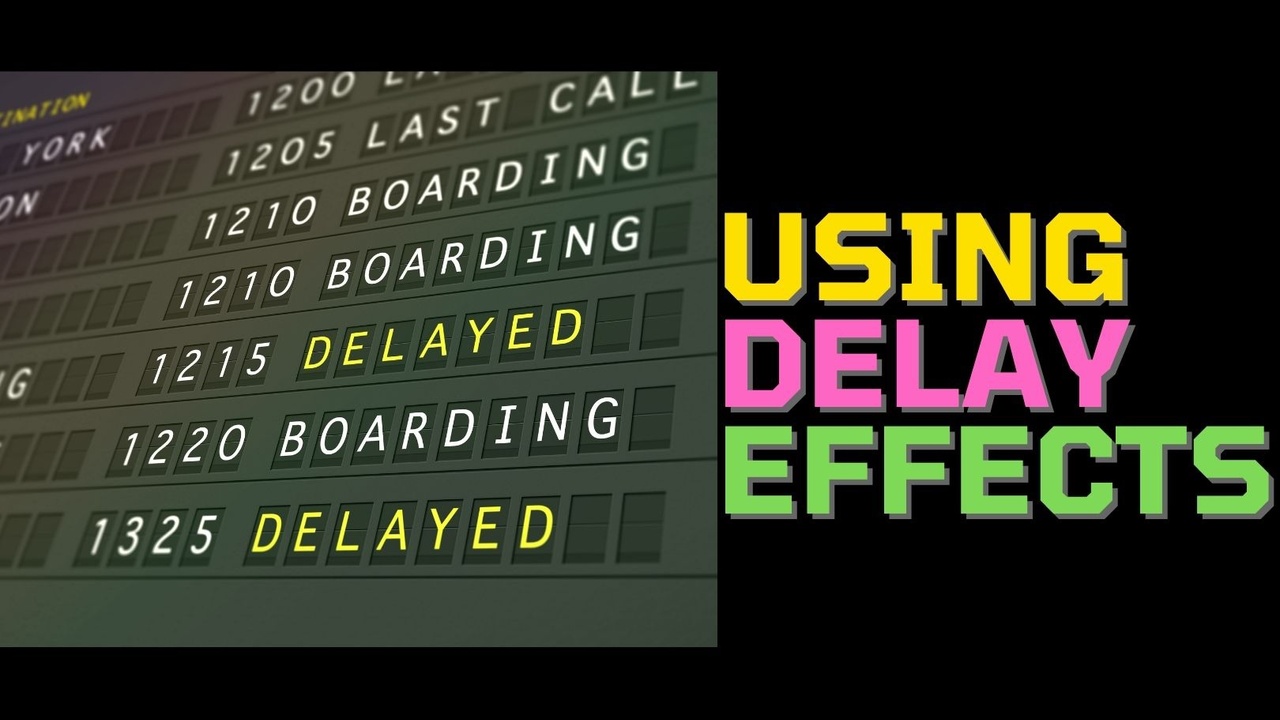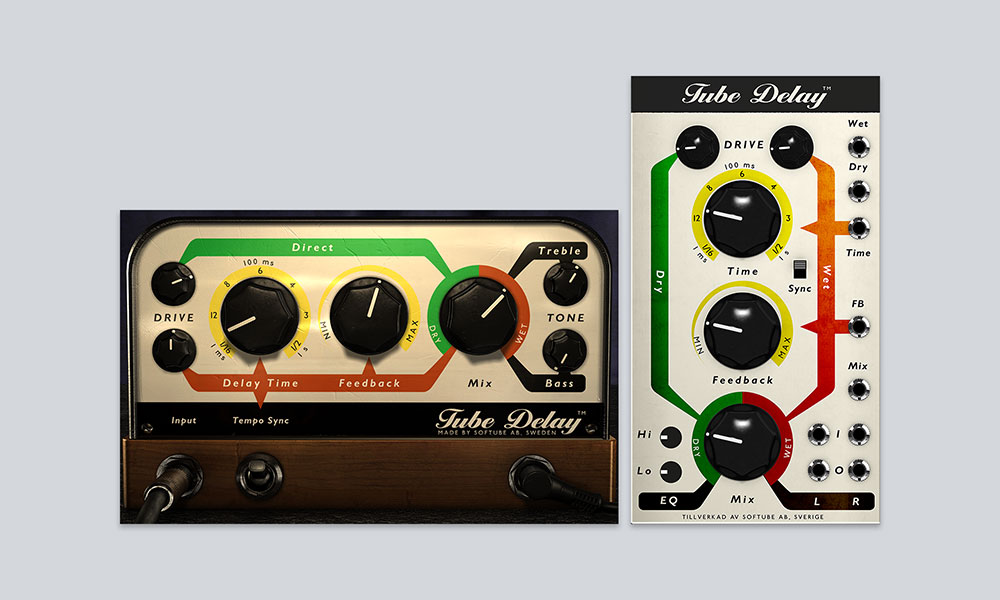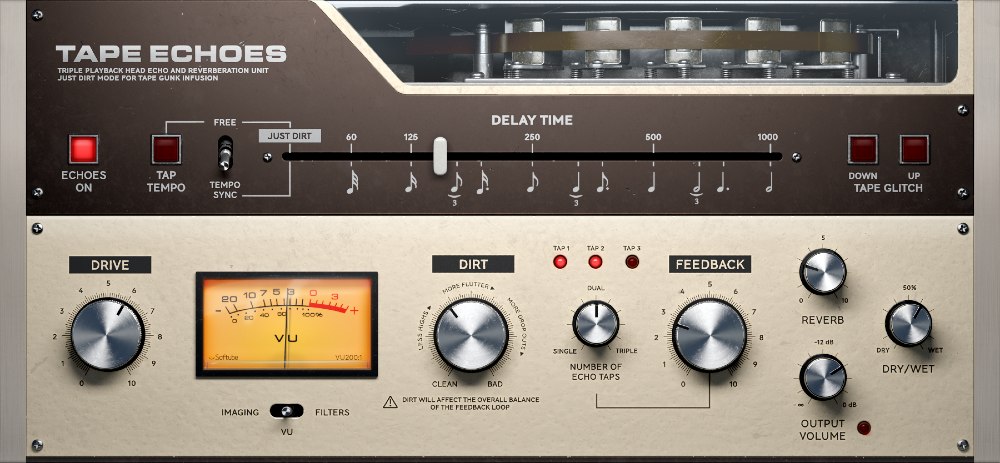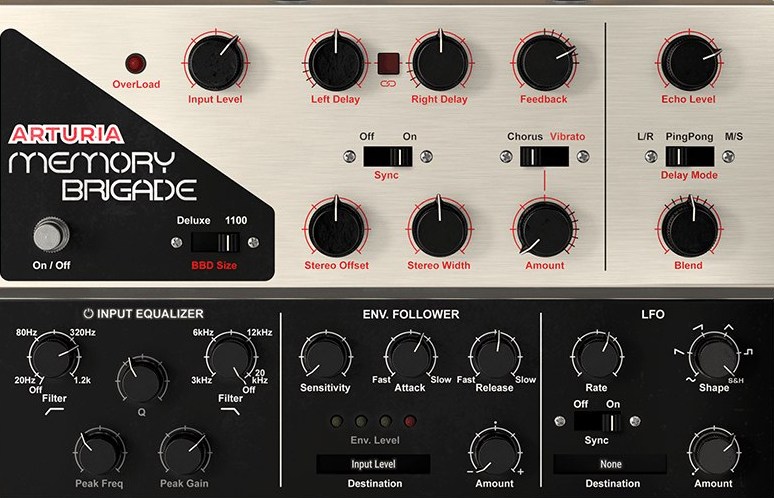How to Use Delay Effects in Music

One of the essential skills as a music producer that you need to have is how to use delay effectively. Whether you are using a delay to create the illusion of space or using delay as a unique production trick, you need to know how to use it properly to make the most out of it. Of course, though there are no hard and fast rules when it comes to music production, and though some of the best delay sounds have come from pure experimentation, having a foundational grasp on delay can help you make better choices in your mixes.
Note: this article may contain affiliate links, which mean that I receive a commission for any purchases you make, at no added cost to you.
Download this Free Cheat Sheet to Learn how to use the 7 Types of Reverb!
What is delay & history of delay effects in Music?
Delay is the process of taking a dry signal and playing it back one or more times to create an echoing sound. The duplicate must appear at least 50ms or more after the initial sound to be an authentic delay sound. Otherwise, these sounds simply sound fused into one to the human ear (and in music, that is often reserved for reverb effects - see this article on the 7 types of reverb effects and how to use them).
Delay is often used as a time-based effect, though it can also be modulated, pitch-shifted, and chorused to use as a unique effect.
The first true iteration of delay in music came about in the 1950s when Les Paul used it as an effect on the song, “How High The Moon.”
This song was groundbreaking in the music realm, creating a uniquely enchanting sound that no one had ever heard before. The sound of this particular delay was known as “slapback” delay and would eventually make its way into the rock, country, and rockabilly scenes.
As more and more companies began developing hardware delay units, it was used more and more in different genres, including dub, reggae, trip-hop, and electronic music.
Types of Delay
There are four main types of delay out there, and each one has its own strengths and weaknesses. The styles of delay VSTs are:
- Tape
- Analog
- Digital
- Echo/Slapback
In this article we'll go over each type of delay plugin and offer some suggestions for when to use it.
If you're in the market for a new delay VST, I've put together this review of the best delay plugins.
How to Use Tape Delay Effects
Tape delay came around back in the 1940s, as many engineers began experimenting with tape decks to try and get new sounds out of them. Engineers discovered that if you changed the length of the loop and adjusted both of the read and write heads, you could get a unique delay sound.
It wasn’t until the 1950s that companies began releasing commercial tape delays, as, before that, many engineers had to use inconvenient tape decks to record delays.
Because these systems were very bulky and sensitive, many engineers found them incredibly difficult to manage. However, they sound absolutely incredible. Many musicians throughout the 20th century, including David Gilmour, Jimmy Page, and Brian May, used tape delay to craft some of their most popular tones.
Because all tape units are different, it is hard to pin down a single tape delay sound. However, for the sake of characterization, it is best to think of it in a warmer, rounder, lo-fi sense. As you increase the feedback on tape delay, sounds tend to get more distorted. You will not get precise delays with a tape machine, though if you’re looking to add some character with noise and pitch wobbles, tape delay might be just the sound you’re looking for.
If you're looking to add tape delay to your sound, we recommend SofTube's Tape Echoes plugin. It nails the classic tape sound, has a beautiful (and easy to use) interface, and allows you to make your tape sound as pristine - or dirty - as you want! On top of that, you can use it to trigger all sorts of classic tape effects, from speeding up to wobbling.
Analog/BBD delay effects
Analog delay has been around since the early 1950s. While some of the earliest forms of delay existed on massive tape decks, they were not portable by any means and had to use pre-recorded sounds to work. Because these machines weren’t real-time units, they could not work for live recording settings.
Eventually, companies began manufacturing sturdier and portable alternatives to these massive tape delays that guitarists could bring with them out on the road.
To achieve this, engineers used bucket brigade circuits. These analog delays used a series of capacitors that would take a small sample of the dry input signal and pass it along to the next capacitor. It received the name bucket brigade due to the fact that it passed on the signal like a bucket brigade would pass along a bucket of water.
Bucket brigade delays have a very dark sound to them, as they are low-passed to preserve sound quality. These types of circuits pioneered a new path for delays, as they were the very first units that could recreate short echoes, perfect for slapback, flanging, and chorusing effects.
Our favorite BBD style analog delay is Arturia Memory-Brigade Delay. It models one of the classic delay effects, heard on countless recordings from U2 to Foo Fighters. This is perfect for dark, modulated delays, lush textures, and far out soundscapes.
Digital delay effects in Music
Digital delay units didn’t come around until the 1970s and 1980s. These units were made to sound much cleaner than analog delays, giving you crisp and clear delay effects. Digital delays were made using DSP. A sample of the signal was sent through the unit where it would be spat out again and again. The only thing that had an impact on the quality of the signal was the A/D conversion and the sample rate speed.
The first iteration of digital delays were rack units found in studios, which were incredibly expensive. Eventually, Boss came up with the very first DD2 pedal in 1984, which made use of an analog to digital converter and could be placed on a pedalboard.
One neat thing about these delays is that people were finally able to use knobs to select the types of delays that they wanted, giving them more control over the tone, size, and shape.
Nowadays, you can find digital delays in the form of plug-ins, even though many delay plug-in manufacturers aim to mimic analog delay units.
Some of the most famous digital delays include:
- Boss DD-2
- Lexicon PCM42
- Ibanez DE-7
Our favorite Digital Delay plugin is Primal Tap by Soundtoys. It offers that perfect, clean digital sound. Even cooler - though - is it allows you to access lo-fi delay sounds of the 1980s to really nail that classic digital vibe. You can also freeze the sounds to create weird, glitchy loops and creative effects.
Echo / Slapback Delay Effects
While echo delay isn’t necessarily a type of delay, many people think of slapback echo when they hear it. As Slapback Delay is one of the most utilized delay effects in music, it is worthy of its own category.
Slapback delay was very common in 1950s rock and roll music. It was most often used on guitars as an effect. Due to the short timing on slapback delay, you could get a bit of extra excitement and energy out of your delay sounds.
With a single repeat, it is a great trick for drawing attention to your dry signal without having to put a massive was of reverb behind it.
Slapback echo works great in songs that are faster in tempo, thanks to the fact that it is very energetic. Plus, if you’re looking to impart a vintage tone on your recordings, slapback delay can work wonders.

If you're looking for classic rockabilly tones, SofTube's Tube Delay is the choice for you. It not only nails the classic, warm slapback tones, but allows for a lot of saturated warm drive. It can even do spaced out dub reggae tricks!
What are the Main Controls on a Delay?
In this section, we'll teach you how to use a delay better, no mater what type of delay you're using! The main controls of a delay are:
- Feedback
- Repeats
- Delay time
- Wet/dry
- Filter
- Wobble
What is delay time and how to set it?
The delay time is the time that it takes your delay to create each successive repeat. As we said earlier, you typically want to set your delay above 50ms to get a true repeat. You can get the longest possible delay with a digital delay, while analog delays and tape delays are much shorter.
As for setting the time for your delay, most people will set it depending on the speed of the music. For example, a slapback delay would work much better for a faster song, as it could create space without clouding the rhythm. On the other hand, a quarter-note ping pong might a better choice for a longer song, as it can fill in the empty space.
If you’re using a delay plug-in, you typically have the option to sync your delay time to your track. This way, if you choose to use an 8th note, for example, the 8th note delay will be in time with your session. When you aren’t syncing to your track, you can use the milliseconds control to adjust your delay time.
What do Repeats Control?
The repeats control on a delay unit controls the intensity of each repeat and tells your delay how many times the signal should repeat itself until it dies out completely. With the repeat control, you can allow your signal to die off very subtly or crank it up so that it feeds back into itself, creating psychedelic mayhem.
With digital delays, you can usually be very precise when it comes to dialing in repeats. For example, if you want your signal to repeat three times before it dies out, you can dial the “repeats” knob into the correct point where it hits three delays before stopping.
What does delay feedback do?
Feedback is the same thing as the “repeats” control, though you will often see the term “feedback” on pedals or plug-ins, depending on the manufacturer. Essentially, feedback allows you to set your decay tail’s length. Each of your delays will get quieter and quieter before, easing its way down to pure silence.
However, if you put your feedback up to 100%, every repeat will be just as loud as the one before it. To get a natural trail, it is important to lower the feedback setting. A feedback setting of 50% will make each repeat half the volume of the one before until your delay moves into silence.
Wet/dry
The wet/dry knob, sometimes referred to as the Mix knob, is there to set the ratio between the wet (delayed) signal and the dry (unprocessed signal). If you insert a delay into your dry signal chain, whether a pedal or plugin, and set the delay to 100%, you will only hear the delay signal. If you set it to 0%, you will only hear the dry signal.
If used as an insert, it is typically best to set your delay anywhere between 10% and 50%. If used as a send in parallel, however, you will want to extend it to 100% so that you can mix the dry signal and wet send with one another to get the correct balance.
Filter Effects for Delay
On many delay units, you will find filters, which can be used to shape the tone of the delay. These filters typically come in the form of low-pass and high-pass filters, allowing you to get rid of highs and lows in your delay signal so that it sits better with the dry signal.
You can think of these filters as built-in delay EQ.
Wobble
On tape delays, it is possible to create unique wobbling sounds with your delay unit, also known as “wow” and “flutter.” Tape delays make use of mechanical rotary components, which can be slightly shifted to create fluctuations in speed. We like to think of this as a simple modulation control that can be used to craft effects that sound very similar to chorus pedals or vibrato pedals.
You hear wobble in a lot of lo-fi music these days, as it helps instruments and vocals that sound too digital and clean sound a bit grittier with more character.
What instruments to use delay effects on and tips for great tones?
Here are some concrete tips for how to use delay effects in music, focused on specific instruments that can sound really good with a touch of reverb!
Delay guitar effect
One very popular effect that you will often find on guitars is the slapback delay. This type of delay effect has been in use since the 1950s. To dial in a slapback delay, you will want to set your delay time anywhere from 75-250ms without any feedback. Typically, if used as an insert, you can set your Mix or Wet/Dry knob to 50% to start, adjusting it as you please.
Another popular guitar delay effect makes use of digital delay with a tap tempo. If you listen to The Edge, the guitarist for U2, almost all of his guitar work makes use of digital delays that are synced to the tempo of the song. With a digital delay, sync your delay up to your track using quarter notes, eighth notes, or 16th notes and play a couple lines to see how it fills in the space in-between.
If you’re going for a reggae or dub guitar tone with deep, warm delay tones, I highly recommend using a vintage tape echo sound, as it can impart a bit of grit onto your tone.
Vocal delay
Very similar to guitars, rock and roll vocals from the 1950s often used slapback delay to create a bit of added energy and excitement, all while giving the vocals space to sit in.
Beyond that, people will often use synced delay to emphasize the ends of certain lyrical phrases. This is called a “throw delay.” The idea is that you only push the fader up to send your vocal into a delay when you want to emphasize the particular phrase. More often than not, a straight eighth note, quarter note, or half note will work best for this.
Producers and engineers will often use delay instead of reverb to give vocals space while keeping them upfront.
Keyboard delay effects
When it comes to keyboard delay effects, it is great to start with an absolute value for the length so that you can stay in time the song. This is especially true if the keyboard part is very rhythmic. Otherwise, you can use a time in milliseconds that is close to relative tempo to create a bit of swing or drive.
The length that you set will also depend on the tempo of your song. It is best to use faster delay times for faster tempos and slower delay times for slower tempos.
Make sure to use the filter parameter on your keyboard delay so that it overwhelms the sound. Because keyboards are very full-spectrum instruments, having a full-spectrum delay can often muddy up the mix. Start with the low-pass filter and bring it up until the delay fits in nicely with the keyboard.
FAQ for Using Delay Effects in Music
Here are some of the most frequently asked we've received about using delay effects in music production.
Should I use stereo delay or mono?
When you have a wide and ambient mix with tons of stereo effects, sometimes the last thing that you want to do is add more stereo delay - so go with a mono delay! When it comes to a vocal, for example, it can sometimes be good to use a mono delay to retain both focus and clarity.
However, in the case that you’re working with a very sparse mix, such as an acoustic guitar and a piano, then using a stereo delay might be just the trick for filling in the empty space.
What’s the difference between delay & echo?
In the audio realm, people often use the terms Delay and Echo interchangeably, as both of these terms are used to take about effects over time. However, when it comes to reality, both of these terms are actually quite different.
We like to think of the term Echo as a subset of the term Delay. Compared to a simple delay repeat, Echo is much thicker and a bit more complex. Often, people will use echo with reverb, overdrive, and filtering of some sort.
Delay is a term that describes the building blocks of echo. The more that you manipulate your delays, the more unique sounds you can get. Many might even say that you can create an echo with delay.
From a Frustrated Producer in a Ragtag Bedroom Studio to Major Placements on TV Earning $1,000s!
My name is Evan, and I've been making music since around 3rd grade. I'm from San Diego, California, but I've lived in Washington, DC for the last 20 years.
While I still have a full-time day job, I have created systems that have allowed me to produce dozens of songs a year in my spare time.
My songs have been on Netflix, TV shows like the 90 Day Fiance, an award-winning indie film, and NPR’s “All Thing Considered.” They've also been streamed millions of times.
In addition to being a music producer, I am passionate about teaching people how they can make professional-sounding music and earn money licensing it, all in their spare time.
Thousands of musicians, like yourself, have trusted me to guide their musical journey. My YouTube videos have been watched nearly a million times. And my story has been in Forbes, Side Hustle Nation, and the Side Hustle School.









